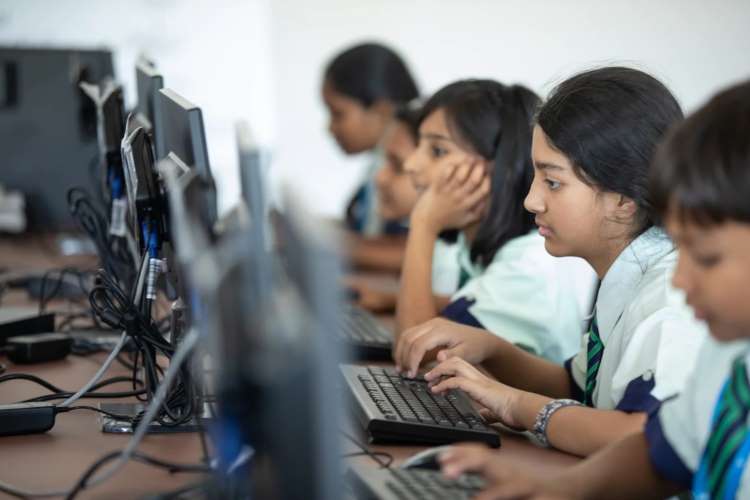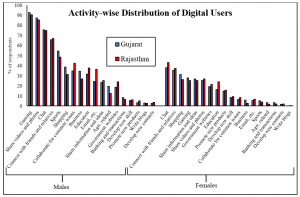
Digital tech and rural development: In the last 5-7 years, digital access has improved remarkably in India. This is evident in the dramatic increase in rural digital subscribers from 92 million in 2015 to 332 million in 2022 (TRAI). Most of the credit goes to the government’s flagship programme Digital India, initiated to connect all the villages with broadband networks. Successive advancements in technology, network strength, decrease in the prices of smartphones and data enabling also helped this digital revolution.
Currently, with over 800 million internet users, India has the world’s second-largest online user base after China (World Development Indicators). Since smartphones allow access to information from any place and time, developmental practitioners and policy makers view it as a tool for bridging the rural-urban divide and socio-economic differences. Over time, several mobile-based apps have been introduced to help rural people reduce their vulnerabilities. Now India is moving from 4G networks to 5G technology that offers better connectivity, 200 times faster download speeds and higher processing rates.
Rural consumers account for roughly 45% of the data usage in the country. During the near total lockdown due to the Covid-19 pandemic, rural data usage soared by 400%. The majority of workers, both skilled and unskilled, returned to their villages during this time. However, this spike in data usage is not reflected in terms of generation of economic activities in the villages.
READ I End of work from home will upset inclusive hiring, work-life balance
Rural development and digital technology
The unlocking process resulted in a return to the pre-Covid migration patterns which saw workers going back to cities, either to rejoin work or looking for new occupations. This indicates that technology helped displaced people find jobs through contacts in cities rather than staying put in villages and joining the rural job market. Technology also allows people to work remotely. However, the ongoing migratory trend raises a key question — how people in rural areas use digital technology.
A survey was conducted in selected villages of Gujarat and Rajasthan during the pre-pandemic time (2018-19). Taking into account the lagged effects of technology, the results of this study gave proper insights in this direction. The study, sponsored by the Indian Council of Social Science Research, studied the influence of socio-economic factors on the digital profile of people. Due to gender-focused socially prescribed roles, males have more free time than females to spend online. However, their digital usage is largely consumptive, i.e., for recreational purposes such as gaming, watching movies and videos, and listening to music.
Women use technology for less time, but their usage is mostly for sharing information and ideas, maintaining relations, promotion of products, and development of new skills. These findings negate the notion that poor digital skills intensify the use of recreational technology in rural areas. Taking into account the notion of learning by doing after attaining the threshold level of digital skills, digital abilities improve with usage. This indicates that digital users are less motivated to use the technology in productive ways.
READ I Rural distress: MGNREGA, PLFS numbers spell trouble
In Rajasthan, the study finds that low literacy rate, less remunerative jobs, poor economic status and social backwardness demotivate people from productive digital engagement, particularly for information search and knowledge expansion. These factors decrease the confidence to develop new contacts and to engage in digital transactions. This confines technology usage to close contact and peer groups.
On the contrary, in Gujarat, two different situations are observed. In some villages, foreign remittances decrease the need to use technology for learning and raising income. In villages where opportunities are available due to highly developed businesses, industries, service sector, and high agricultural productivity, technology is used more productively. It was visualized even among people belonging the socially backward groups.

Despite all limiting factors, digital technology is found to have a positive relationship with income and opportunities in non-farm sector, learning opportunities, as well as maintenance of social relations. Since agriculture is a seasonal occupation, during the off-farming months, the technology is increasingly used for passing the time. This suggests that the positive effects of technology are negated by its excessive use for leisure activities.
In order to leverage the benefits of digital access in rural development, the study recommends increasing income generation activities in villages. This should include development of business activities and integration of rural markets with a larger supply chains. Young people’s migration will consequently decline, resulting in more technological support in remote areas which will, in turn, increase the level of confidence for other digital activities. Since the rural people are resource poor, policy initiatives are required in this area.
Freeing up resources from free transfers and diverting them for creating opportunities will encourage productive digital engagement by individuals which should have positive implications for rural development. Improving secondary and senior secondary education facilities will also enhance the impact of digital access in rural areas. The study concludes that excessive data use for recreation offsets the benefits of digital technology in rural areas.
(Dr Hansa Jain works at Sardar Patel Institute of Economic and Social Research, Ahmedabad. This study is part of a project sponsored by ICSSR, New Delhi.)
